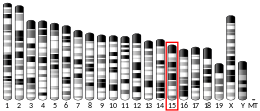CACNA1I
Calcium channel, voltage-dependent, T type, alpha 1I subunit, also known as CACNA1I or Cav3.3 is a protein which in humans is encoded by the CACNA1I gene.[5][6][7]
Function
Voltage-dependent calcium channels can be distinguished based on their voltage-dependence, deactivation, and single-channel conductance. Low-voltage-activated calcium channels are referred to as 'T' type because their currents are both transient, owing to fast inactivation, and tiny, owing to small conductance. T-type channels are thought to be involved in pacemaker activity, low-threshold calcium spikes, neuronal oscillations and resonance, and rebound burst firing.[5]
See also
References
- GRCh38: Ensembl release 89: ENSG00000100346 - Ensembl, May 2017
- GRCm38: Ensembl release 89: ENSMUSG00000022416 - Ensembl, May 2017
- "Human PubMed Reference:". National Center for Biotechnology Information, U.S. National Library of Medicine.
- "Mouse PubMed Reference:". National Center for Biotechnology Information, U.S. National Library of Medicine.
- "Entrez Gene: CACNA1H calcium channel, voltage-dependent, T type, alpha 1I subunit".
- Mittman S, Guo J, Emerick MC, Agnew WS (July 1999). "Structure and alternative splicing of the gene encoding alpha1I, a human brain T calcium channel alpha1 subunit". Neurosci. Lett. 269 (3): 121–4. doi:10.1016/S0304-3940(99)00319-5. PMID 10454147.
- Catterall WA, Perez-Reyes E, Snutch TP, Striessnig J (December 2005). "International Union of Pharmacology. XLVIII. Nomenclature and structure-function relationships of voltage-gated calcium channels". Pharmacol. Rev. 57 (4): 411–25. doi:10.1124/pr.57.4.5. PMID 16382099.
External links
- CACNA1i+protein,+human at the US National Library of Medicine Medical Subject Headings (MeSH)
- Human CACNA1I genome location and CACNA1I gene details page in the UCSC Genome Browser.
This article incorporates text from the United States National Library of Medicine, which is in the public domain.



